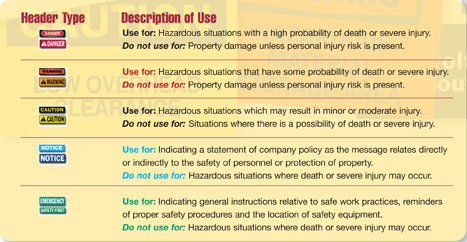
Signs are among the most basic forms of universal communication. They help us locate a bus stop and warn us of extremely dangerous situations. Because we live in a bi-lingual, multi-cultural society, the information conveyed by signage, especially in hazardous situations, must be easily understood by everyone.
OSHA regulation governing safety signs
ANSI Z535 and OSHA Specifications for Accident Prevention Signs (OSHA 1910.145) require the use of safety signs to indicate and define specific hazards that, without identification, may lead to accidental injury to workers and/or the public or to property damage.OSHA 1910.145 specifically defines both danger and caution signs. The regulation for danger signs says, “There shall be no variation in the type of design of signs posted to warn of specific dangers and radiation hazards” (1910.145(c)(1)(i). Regarding caution signs, the regulation states, “Caution signs shall be used only to warn against potential hazards or to caution against unsafe practices” (1910.145(c)(2)(i).
Color is a critical component of safety signage. Red, black, and white are designated for danger signs. Caution signs have a yellow background and a black panel with yellow letters. Text used on the yellow background must be black.
Biological hazard signs are used “to signify the actual or potential presence of a biohazard and to identify equipment, containers, rooms, materials, experimental animals, or combinations thereof, which contain, or are contaminated with, viable hazardous agents” (1910.145(e)(4).
OSHA also regulates the safety of the actual sign design. Signs must have rounded or blunt corners with no sharp edges or projections. The wording on safety signs must be concise and easy to read and indicate positive actions rather than negative.
ANSI regulation for safety signs
The ANSI Z535 Committee on Safety Signs has developed standards for the design, application and use of signs, colors, and symbols to identify and warn against specific hazards and for other accident-prevention purposes.The format recommended by ANSI is intended to provide a safety alert message that is clearly and rapidly understood. ANSI Z535.3 addresses the issue of the multi-ethnic, highly mobile U.S. population, stating that word-only signs are not nearly as effective in promoting safety as are those that use appropriate safety symbols. Lettering is left justified, as well as upper and lower case to enhance legibility, while internationally recognized pictograms are used for universal comprehension.

How to choose the correct sign header
Following is a guide to choosing the appropriate sign classification for your application that is in compliance with OSHA and ANSI standards.Choosing the right material
There are a variety of materials that are OSHA and ANSI compliant, but to get the most value, you must first weigh cost against durability and longevity. For example, if you are purchasing signage for a harsh, dirty environment, the materials used must be durable in extreme situations.The following materials are best suited to specific signage needs and applications:
- Fiberglass: Designed for longevity, fiberglass won’t rust, chip, or peel. It is ideal for outdoor or harsh environments and has a life expectancy of approximately 15 years.
- Reflective sheeting on aluminum: Chemical-, abrasion- and weather-resistant, this material offers excellent night and day visibility with an outdoor life expectancy of approximately eight years.
- Plastic: This economical material is ideal for light duty and has an outdoor life expectancy of up to two years.
- Flat-screened steel: Made with rugged, 18-gauge steel with a baked enamel finish, this option provides good daytime visibility and longevity for outdoor use.
- Diamond grade reflective aluminum: This heavy-duty aluminum has a higher level of reflective sheeting for maximum visibility 24 hours a day.
- Indoor vinyl: Flexible vinyl is economical and suitable for indoor use.
- Self-sticking polyester: With a permanent adhesive backing that bonds to almost any shape or surface, these signs have an outdoor life of up to eight years.